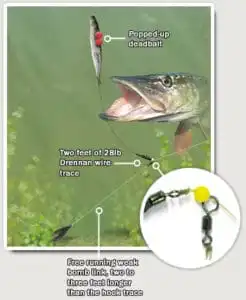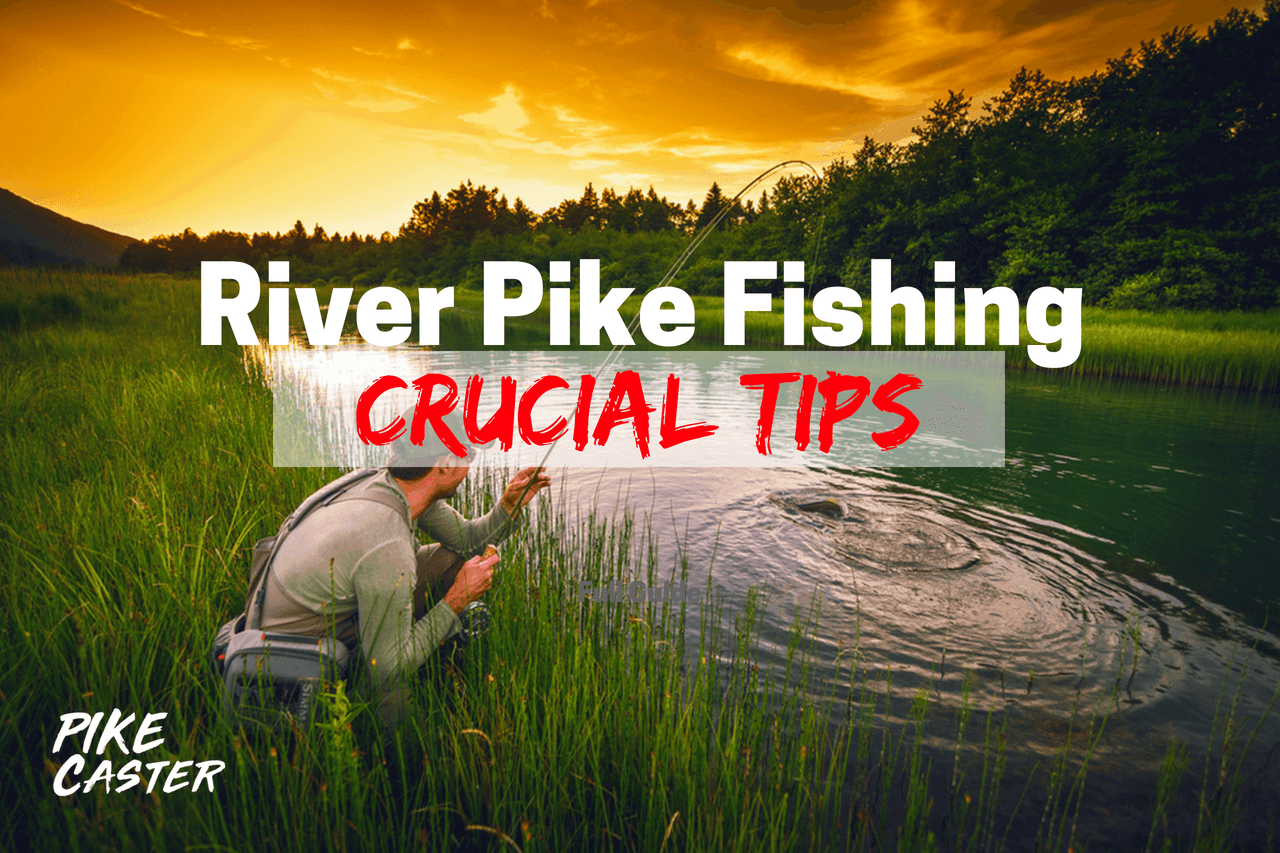River pike fishing can be tricky – That’s a thought I had a while ago when I took my friend on a fishing trip. You see, while I have been fishing since childhood, my friend only recently got the fishing fever. He had only caught one northern pike in his life, but that was enough to get excited about it.
Pike is a predator fish, who takes advantage of the surroundings. In rivers, pikes usually stay out of the stream, hiding in water weeds and lily pads. A great place to start would be the turning points of a river or river mouths. When it’s warm, pikes move to deeper waters.
In order to be successful in river pike fishing, you’ll need to be prepared in the following: know which river you are fishing at, know where to find pike in rivers, know about pikes diet and when they feed, have the right lures and rigs.
Seeing how my friend was struggling to get ready for our trip and asking all sorts of advice, I figured I’d gather all my knowledge and create a guide for river pike fishing.
Which Rivers Are Best For Pike Fishing?
Before heading out to a river for pike fishing, it’s a good idea to do some research about the river you’ve picked. That’s because not all rivers are suitable for and preferred by pikes.
When you search for great rivers to fish pike at, try to find a slower stream river with lots of turning points. As I mentioned before, pikes like to hide out at spots, that provide cover for them while they hunt for their prey.
Also, the ecosystem of the river is somewhat important. You can read all about what pikes feed on in my other post. The reason why the ecosystem isn’t the most crucial element is that pikes aren’t especially picky when it comes to food. For example, they are known to catch frogs, mice, and even waterfowl.
While they do swim in shallower rivers, pikes usually live in rivers with deeper riverbeds. This means, there should have to be at least some spots where the river is about 6-10 ft deep.
Where To Find Pike In The River?
In the last chapter, I advised finding rivers which don’t necessarily have fast streams. Pikes are rarely found fighting the full current because it’s too much hard work and burns up too much energy for this somewhat lazy fish.
A good place to start fishing for pike would be in a place where the river turns. Usually, the outer curve of the river has a slower stream which means, that it would be a great place for a pike to hunt for its prey. Pikes prefer to sit in the slack water alongside the main flow to pick off passing prey which is caught in the turbulence.
It’s also very helpful if there are overgrown trees or bushes on the river bank. This provides more shade for the pike and helps to protect from outside threats like bigger birds and mammals. Be careful not to cast your lure into these trees as bushes – it can be agonizing to retrieve the lures – not to mention to lose them altogether.
Another great place for finding pike in the river is in river mouths. These are placed where the river has carved into the bank, leaving a still water pool. As river mouths don’t have fast streams, they are usually covered with water plants like lily pads.
Lily pads and other water plants are usually a very good indication, that pikes are hunting for prey near them. And what a show it is, when a pike attacks your lure in the midst of the water flora. It’s a great idea to use either topwater lures like these frog baits from Amazon or weedless lures. Both of those types of lures are essential when pike fishing (doesn’t matter in a river or a lake).
For weedless lures, I like the most the Rapala rattlin’ minnow spoons because they work PERFECTLY. You can check the current price on Amazon. I just recently went for the package deal, because you never know what color the pike wants on that specific day, and also, while weedless, you can still lose them at times.
Once you’re at the river, take a look at the current weather and if possible, the water temperature. The temperature of the water is known to help identify where the pike might currently position itself. For example, if it’s a beautiful sunny and warm summer day, the water is most likely to be warm. Seeing, as pikes like a bit colder water, they usually stay at deeper levels of the river.
Fish Finder
Using a fish finder can dramatically increase your chances of catching pike. This also helps you save a lot of time finding the right spots to fish at.
The reason, why fish finders are in most cases the perfect companions, is because you can get a great reading of the riverbed in your location. In short, fish finders help you visualize the river without water, and give you a great overview of where to look for pike.
By knowing all the drop-offs and vegetation of the river floor, it’s much easier to define where you should cast your baits or lures to start catching some pike.
When choosing the right fish finder, it’s important to consider the universality of the finder. It’s a great idea to go for a fish finder which you are able to use in a boat as well as in riverbank fishing. Also, you can use it when ice fishing for pike.
I have found that the best representation of those two categories is the Deeper fish finder. And really, the reason is quite simple. Deeper is one of the most compact fish finders out there, that you can successfully use both in a boat and while standing on a riverbank or at a lake.
You can cast the fish finder out into the water using your fishing setup and just reel it back in. The finder gives a very detailed and accurate reading of the waters in your mobile device, so you don’t need to buy a separate display.
The Deeper fish finders go for $100-$200 in Amazon, depending if you pick the Deeper Start, Deeper Pro or Deeper Pro+.
Small River
Although some might find it controversial to fish for big pike at small rivers, these sort of bodies of water can actually contain monsters. Small river pike fishing is a superb choice if you’re going after numbers.
Most of the pike you find in smaller rivers might not be 20-30 lbs, but regardless of their size, pike usually give a great performance.
Fishing for pike at a smaller river has its perks. Smaller rivers usually have lower streams, more turns, and more obstructions. This, in turn, means, you can effortlessly find a lot of great places to fish for pike.
Whenever I go fishing in a smaller river, I try to find spots, where the river is deeper and has a slower stream – as pike are somewhat lazy and don’t want to waste extra energy fighting the current.
I have found that the best time of the day for river pike fishing is usually either during sunrise or sunset. These are the commonly known golden hours when the pike is more active and looking for prey.
In small rivers, the weather plays more role than in big rivers. As the weather gets warmer, pike tend to go into the deeper water to stay comfortable. In other words, pike locate in different spots of the river during different seasons.
Big River
If you’re going after big pike, It’s definitely a good idea to try big rivers. And it seems logical, right? The bigger rivers usually contain a larger variety of species to hunt, bigger preys, and thus make them a perfect location for huge 20+ lbs pike that everyone is ultimately after.
When it’s fairly simple to find good spots for pike in small rivers, it’s usually a bit more work in big rivers. There is just more water to cover and a lot more places where pike can hide.
Nevertheless, the general principles of pike fishing still imply here as well: Pike like colder water, they’re more active at sunrise and sunset, they tend to keep out of the mainstream, and like weeds and drop-offs.
The best seasons for pike fishing in a big river are from fall to spring. Then, pike are usually more active due to the cooler water conditions and you’re much more likely to catch them with lures.
If you’re going pike fishing during summer, I would strongly suggest live bait rigs, as you can leave your bait near the bottom for longer, hence giving more time for pike to attack.
Lures
Let’s talk about what lures to use when your out river pike fishing. In my experience, there are some guidelines to follow when choosing the right lures.
When choosing the color of the lure, take a look at the water you are fishing at. I have noticed, that if I fish at a clear water river, its best to use natural color and pattern lures that pike can relate to.
Vice Versa, if I’m fishing at a muddier river with lower visibility, I tend to have more success with bright colored lures – e.g. these Rapala X-Rap jerkbaits. The X-raps have rattles inside them, which brings us to the next point.
Vibration. Sometimes, all you need to entice a pike into biting your hook is a noisy lure. I think this is why the X-raps work so well in different conditions. They’re big, they’re shiny, and they rattle.
In case I want to cast a lure work well in unclear waters and gives off a great vibration – I usually go with the Vibrax spinners. These have a bell-like body which rattles by rotating on the inner wheel. You can check the current price on Amazon.
Rigs
The Matt Hayes leger rig
This is the main rigging setup that I have used when pike fishing with live bait. Why? It’s fairly easy to set up, doesn’t tangle and most importantly – catches big pike.
By using a leger rig with a bomb link two to three feet longer than the trace, you eliminate tangles on the cast.
The inertia of the cast causes the trace and the long bomb link to fly apart and fly through the air like a helicopter. Once the lead hits the bottom, you can tighten right up to the lead.
As the bomb link is free running, the fish won’t feel the weight when it takes the bait. A resistance-free rig is important as pike hate resistance and will quickly eject any bait that they feel is wrong.
The paternoster rig is great for fishing on the deck, or for presenting live baits or pop-up deadbaits over weed (see diagram).
I read about this rigging setup from AnglingTimes a few years ago and since it has been working so good for me, I want to share it with you, as well.
Source: https://www.anglingtimes.co.uk/advice/tactics/articles/matt-hayes-how-to-catch-pike
